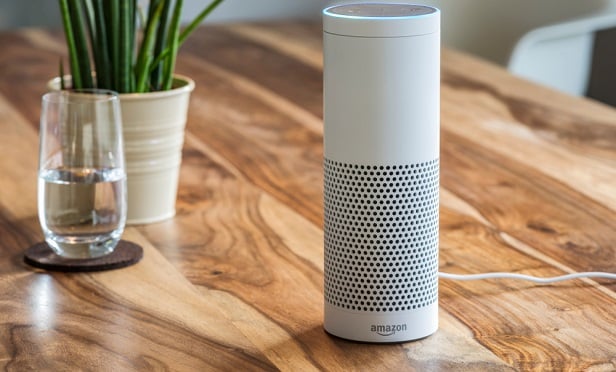 This year, 56.3 million personal digital assistants, including Alexa, Google Assistant and Apple's new HomePod, will ship to homes. What can those devices do for health care? (Photo: Shutterstock)
This year, 56.3 million personal digital assistants, including Alexa, Google Assistant and Apple's new HomePod, will ship to homes. What can those devices do for health care? (Photo: Shutterstock)Has Alexa changed your life yet? Vacuum the floor, start the dishwasher, feed the cat, clean the litter box, order more paper towels and lower the thermostat. Those are just a few items from the to-do list I handed over to artificial intelligence (AI) today—and all without one manual click or key stroke. Whew, no more straining my index finger to push all those buttons.
While all of this has a certain “cool” factor, it's also completely transforming our lives. Gone are the days when AI meant a robot like C-3PO or Rosie from “The Jetsons.” AI is no longer a futuristic sci-fi hope; it's a set of algorithms and technologies known as machine learning (ML).
We're quickly moving toward this technology powering many tasks in everyday life. But what about health care? How might it impact our industry and even our day-to-day jobs? I'm sharing 4.5 things you should know about artificial intelligence and machine learning in the health care industry and how it will impact our future.
Related: Using AI for health care cost prediction and prevention
1. There's a difference
Jeff Bezos, visionary founder and leader of Amazon, made this declaration last May: “Machine learning and artificial intelligence will be used to empower and improve every business, every government organization, every philanthropy; basically, there's no institution in the world that cannot be improved with machine learning and artificial intelligence.”
These two terms have emerged as key buzzwords, and oftentimes are used interchangeably. So, what's the difference?
Artificial intelligence is the ability of machines to behave in a way that we would consider “smart.” In other words, the capability of a machine to imitate intelligent human behavior. Artificial intelligence is the ability to be abstract, creative and deductive—to learn and apply learning. Siri and Alexa are good examples of what you might be using today. In health care, an artificial virtual assistant might have conversations with patients and providers about lab results and clinical next steps.
Machine learning uses artificial intelligence to process large amounts of data and allows the machine to learn for itself. You've probably benefited from machine learning in your inbox. Spam filters are continuously learning from words used in an email, where it's sent from, who sent it, etc. In health care, a practical application is in the imaging industry, where machines learn how to read CT scans and MRIs, allowing providers to quickly diagnose and optimize treatment options.
2. Health care is primed for disruptors
It's no secret that interacting with the health care system is complex and frustrating. As consumers are paying more out of pocket, they're expecting and demanding innovation to simplify their lives, help them become educated, and save money. At the same time, we're starting to get a taste of what machine learning and AI can do for our daily lives. These technologies will dramatically change the way we work in health care. Don't take my word for it; just review a few of the headlines over the past year:
- A conversational robot explains lab results.
- A health care virtual assistant enables conversational dialogues and pre-built capabilities that automate clinical workflows.
- Google powers up artificial intelligence, machine learning accelerator for health care.
- New AI technology uses brief daily chat conversations, mood tracking, curated videos, and word games to help people manage mental health.
- A machine-learning algorithm helps identify cancerous tumors on mammograms.
Soon, will a machine learning algorithm serve up a choice of three benefit plans that are best for my situation? Maybe Siri or Alexa will even have a conversation with me about it.
3. Be smart about customer data
Working around health care and seeing the recent breaches, most of us have learned to be very careful about our security policies and customer data. As the use of machine learning grows in health care, continue to obsess over the privacy of your customer data. There are two reasons for this.
First, data is what makes machine learning and AI work. Without data, there's nothing to mine and that means there's no info from which to learn. Due to the sheer amount of data that machine-learning technology collects and consumes, privacy will be more important than ever. Also, there's potential for a lot more personally identifiable data to be collected. It will be imperative that companies pay attention to masking that data so the specific user is not revealed. These steps are critical to ensure you and your customer are protected as laws continue to catch up with this emerging technology
Second, you're already collecting a lot of data on your clients, of which you may not be taking full advantage. As more data is collected, it's important to keep it organized so that you can use it effectively to gain insights and help your clients. Data architecture is a set of models, policies, rules or standards that govern which data is collected, and how it is stored, arranged, integrated and put to use in data systems and organizations. If you're not already thinking about this, it might be a good idea to consult with a developer to get help.
4. Recognize where the customer is today and plan for tomorrow
What's the consumer appetite for these types of technologies? This year, 56.3 million personal digital assistants, including Alexa, Google Assistant and Apple's new HomePod, will ship to homes. That's a 40 percent increase from the impressive 33 million sold in 2017. Consumers are quickly changing where they shop, organize and get information. It's important that we move quickly to offer the experience customers want and need.
At first, I was happy to ask my Alexa to play music and set timers; now it's the hub of my home. Alexa shops for my groceries, provides news stories, organizes my day and much more. Plus, the cat really appreciates when Alexa feeds her. (I'm totally serious: my cat feeder is hooked up to Alexa, who releases a ration of kibble at pre-set feeding times.)
There are so many applications for health care. Here's a few that are happening or just around the corner:
“Alexa, what's left on my health plan deductible?”
“Alexa, find a provider in my network within five miles.”
“Alexa, search for Protonix pricing at my local pharmacies.”
“Alexa, how do I know if I have an ear infection?”
“Alexa, what's the difference between an HSA, FSA and HRA?”
“Alexa, find a 5-star rated health insurance broker within 20 miles.”
4.5 The customer experience must be truly helpful
Making “cool” innovations in AI or machine learning won't work if they're not coupled with a relentless pursuit to serve the customer. These endeavors are expensive, so spend your IT budget wisely, ensuring new innovation creates true value and is easy for the end user.
 Ready to learn more? Join Tonia Degner and Reid Rasmussen, co-founder and CEO of freshbenies for their breakout session at BenefitsPro Broker Expo.
Ready to learn more? Join Tonia Degner and Reid Rasmussen, co-founder and CEO of freshbenies for their breakout session at BenefitsPro Broker Expo.
© 2025 ALM Global, LLC, All Rights Reserved. Request academic re-use from www.copyright.com. All other uses, submit a request to asset-and-logo-licensing@alm.com. For more information visit Asset & Logo Licensing.







